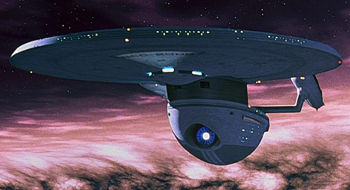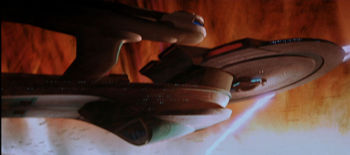Excelsior class

Excelsior class (ST-06)

Excelsior class refit (ST-07)
In October 2284, the U.S.S. Excelsior NX-2000, the first of a new class, was commissioned. This vessel was the newest in Starfleet, and it incorporated many experimental operating systems.[3] Originally designed as a test-bed for the experimental transwarp drive, the Excelsior was called “The Great Experiment” by many in influential circles.[1] These ships were the newest of any in Starfleet and incorporated experimental technology in most of the components required to operate a starship. With so many new systems aboard these vessels, the process of testing them was slow. Prior to being installed, each component was tested and retested until it met standards. Nevertheless, when the Excelsior was taken out for trials, the evaluation teams were constantly faced with primary system malfunctions that would not allow any of the secondary or backup systems to be tested. This caused the evaluators to deal with these new components on a one-at-a-time basis, and thus creating time delays in the commissioning of the class.[3]
The Excelsior class underwent a number of late design changes when the transwarp project ultimately failed. While transwarp was never realized, designers were unwilling to cast aside what was otherwise a sound cruiser design. The transwarp engines were removed in favor of conventional linear warp drive engines. The Excelsior class could cruise at Warp 8, sustain speeds of Warp 10 for several hours, and reach Warp 13 when necessary. This made it by far the fastest Starfleet vessel for almost five decades.[31]
After these changes were made, Starfleet built a second, the U.S.S. Proxima NCC-2001, which finished her trials early 2286 and was commissioned immediately thereafter. Soon after that, the U.S.S. Columbia NCC-2002, was completed, while U.S.S. Galacta NCC-2003 began her trials in the latter part of that year. All of these ships were constructed at shipyards orbiting Earth and .[3]
A state-of-the-art capital ship with impressive size, speed, and tactical characteristics, the Excelsior class was well-suited for a number of mission roles. Specializing in emergency response and long-range exploration, the Excelsior class also distinguished itself through superior firepower and the ability to project force into neighboring sectors. They served as the mainline fleet vessel for Starfleet after the retirement of the Constitution class, and before the wide-scale use of Ambassdor class ships. They frequently operated as command and control vessels, dictating fleet actions. A number of scientific laboratories and the ability to launch long-range probes also made the class viable for exploration and scientific missions. As a support vessel, the ship’s sensor capabilities were average for its class, while its operations and computer systems were top of the line. A large shuttlebay and ample cargo room gave the class the ability to operate in a number of auxiliary roles, such as colony supply, emergency relief, and deep-space surveying missions.[31]
The flagship of Starfleet, the U.S.S. Enterprise NCC-1701-B, was commissioned as an Excelsior class vessel,[20] while the Excelsior herself went on to a fine and distinguished career under Captain Hikaru Sulu.[14] The U.S.S. Gorkon NCC-40521 and U.S.S. Cairo NCC-42136, commanded by Captains Nechayev and Jellico, respectively, saw extensive action against the Tholians and Cardassians in a number of conflicts.[31]
Tactically, the Excelsior class was the most powerful Starfleet vessel fielded during the 23rd and early 24th centuries. Mounting several Type-VIII phaser banks, the Excelsior‘s firepower provided it with excellent strike capabilities. The addition of Mk 22 direct-fire photon torpedoes allowed the class to lay down multiple fields of fire. Supplemented by the proven CIDSS-2 shield system, the class enjoyed significant combat endurance.[31]
During the Cardassian and Dominion wars, the Excelsior class was an oft-seen combatant on the front lines. Excelsior cruisers fought at the Chin’toka, Archanis, and Bolian sectors, to name a few, in the latter parts of the Dominion War.[31]
Ships of the class:
Statistics
References
- 1. Star Trek III: The Search for Spock. Film. 1 June 1984.
- 2. “New Frontiers, Chapter 7: The Beginning of the End…” Star Trek, Volume 1 Issue 15. Comic Book. June 1985. DC Comics.
- 3. “Federation Ship Recognition Manual.” Star Trek: The Roleplaying Game, Supplement 2302. Game. 1985. FASA.
- 4. “Encounter at Farpoint.” Star Trek: The Next Generation, Episodes 101-102. Television. 28 September 1987.
- 5. “Where No One Has Gone Before.” Star Trek: The Next Generation, Episode 106. Television. 26 October 1987.
- 6. “Angel One.” Star Trek: The Next Generation, Episode 115. Television. 25 January 1988.
- 7. “11001001.” Star Trek: The Next Generation, Episode 116. Television. 1 February 1988.
- 8. “The Neutral Zone.” Star Trek: The Next Generation, Episode 126. Television. 16 May 1988.
- 9. “The Child.” Star Trek: The Next Generation, Episode 127. Television. 21 November 1988.
- 10. “Star Trek: The Next Generation Officer’s Manual.” Star Trek: The Roleplaying Game, Supplement 2012. Game. 1988. FASA.
- 11. “Peak Performance.” Star Trek: The Next Generation, Episode 147. Television. 10 July 1989.
- 12. “Sins of the Father.” Star Trek: The Next Generation, Episode 165. Television. 19 March 1990.
- 13. “The Most Toys.” Star Trek: The Next Generation, Episode 170. Television. 7 May 1990.
- 14. Star Trek VI: The Undiscovered Country. Film. 6 December 1991.
- 15. “Chain of Command, Part II.” Star Trek: The Next Generation, Episode 236. Television. 14 December 1992.
- 16. “Descent.” Star Trek: The Next Generation, Episode 252. Television. 21 June 1993.
- 17. “Invasive Procedures.” Star Trek: Deep Space Nine, Episode 424. Television. 18 October 1993.
- 18. “Paradise.” Star Trek: Deep Space Nine, Episode 435. Television. 14 February 1994.
- 19. “Thine Own Self.” Star Trek: The Next Generation, Episode 268. Television. 14 February 1994.
- 20. Star Trek: Generations. Film. 18 November 1994.
- 21. “Caretaker.” Star Trek: Voyager, Episodes 101-102. Television. 16 January 1995.
- 22. “Homefront.” Star Trek: Deep Space Nine, Episode 483. Television. 1 January 1996.
- 23. “…Nor the Battle to the Strong.” Star Trek: Deep Space Nine, Episode 502. Television. 21 October 1996.
- 24. “For the Uniform.” Star Trek: Deep Space Nine, Episode 511. Television. 3 February 1997.
- 25. “Unity.” Star Trek: Voyager, Episode 159. Television. 12 February 1997.
- 26. “Tears of the Prophets.” Star Trek: Deep Space Nine, Episode 550. Television. 15 June 1998.
- 27. “Star Trek: Deep Space Nine Technical Manual.” Book. 1998.
- 28. “Chasing Shadows.” Star Trek: The Next Generation – Intelligence Gathering, Issue 3. Comic Book. March 2008. IDW Productions.
- 29. “Do Not Close Your Eyes.” Star Trek: The Last Generation, Issue 1. Comic Book. November 2008. IDW Productions.
- 30. “Starfleet Operations Manual.” Star Trek Roleplaying Game, Book 3. Game. 2003. Decipher, Inc.
- 31. “Starships.” Star Trek Roleplaying Game, Book 4. Game. 2003. Decipher, Inc.
Leave a Reply
Categories
- Animated Series (60)
- Articles (28)
- Books (447)
- Cast & Crew (79)
- Comics (22)
- DS9 (328)
- Early Voyages (125)
- Education (5)
- Enterprise (373)
- Excelsior (36)
- Food (19)
- Games (223)
- Klingon (70)
- Library (1,543)
- Logs (593)
- Lost Era (55)
- Medicine (18)
- Merrimac (1)
- Mirror (35)
- Miscellaneous (13)
- New Frontier (54)
- Next Generation (635)
- Original Series (681)
- Personnel (436)
- Places (369)
- Politics (12)
- Recreation (10)
- SCE (41)
- Science (1)
- Shatnerverse (9)
- Ships (455)
- Site Updates (98)
- Starfleet Academy (86)
- Stargazer (42)
- STO (61)
- Technology (45)
- Titan (59)
- To Boldly Go (1)
- TV/Film (214)
- Uncategorized (4)
- Vanguard (76)
- Voyager (236)
- Weapons (27)
- Xenology (54)